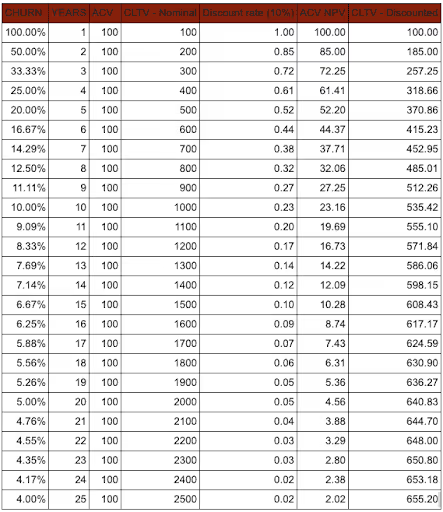Monday Price Point:
Churn can be too low.
If higher prices creates higher churn, then you have a choice: money now or money later?
So there is some intuitive relationship between prices and churn.
Let me unpack this.
Generally the rule of thumb is ‘Divide by churn’. So a 10% annual churn rate means that customers stay 10 years on average. And a 5% monthly churn rate means they stay for 20 months on average.
If you have a 5% annual churn rate this means that you are betting on collecting money from customers in 2045.
Set aside for a minute that a lot can happen (and usually does) in 20 years - even if this cashflow actually comes in as planned, then time value of money is still relevant.
In other words: $100 today is worth a lot more than getting $100 in 2045.
The financial term used to describe this value of time is the ‘discount rate’. It’s basically expressed as a percentage drop in value per year. So a 10% discount rate means that $90 today should be worth as much to you as a certain $100 one year from now.
This compounds so at a 10% discount rate the value drops by 88% over 20 years (0.9^20=0.12).

What is the right discount rate? Well, nobody knows. Financial systems use the 10 or 30 year bond interest rate, but this is a measure of the overall economy that moves slower. If you’re in tech, then a higher discount rate is probably better.
Basically you take the average of these three questions: How many years will it take for my market and solution space to be completely changed?
New tech. New players. New market dynamics.
This is a measure of overall Time Risk. → If the answer is 5 years - you should probably discount ~20% or so. At what rate can you reinvest money in your existing business?
If you have $100 today can you turn it into $200 next year by funding Sales/Product/?. → If you can get a 100% ROI on invested capital, then a 50% discount rate is right for you.
Do we have any personal adjustments we want to make? E.g. are we just more comfortable with longer, more stable relationships? What do our investors care about? Etc.
This second question also covers the opportunity value of keeping the customer. If you have the relationship for another year, how much can you expand ACV?
Basically a 110 NRR completely negates a 10% discount rate. But this usually comes at a cost in terms of continued product development and sales, keeping the org intact and so fort.
And the 3rd question is for sure a backdoor that allows you to do whatever you want. Which is fine. It’s your business. Just be aware what the first 2 questions are telling you and then be clear that any divergence from that is your preference.
So: if the market takes 10 years to fundamentally change (10 years) and we can have a 30% ROI on invested capital ( 3.3 years -ish), then we’re probably looking at a 6-7 year revenue horizon which means we should be fine with a 14-16% churn rate.
Which to most B2B SaaS feels HIGH!
… so maybe you just decide that half that is what is right for you and settle on 7-8% churn.
The math can be made more complicated, but my general rule of thumb is this:
RULE: If churn is lower than the discount rate you should raise prices until it isn’t.
Here i how you do it:
- Segment your customers (e.g. S/M/L, by vertical - whatever suits you).
- For each segment: calculate churn.
- Have a discount rate discussion with your senior management team.
- Settle on a discount rate.
- Explain your logic to board / investors.
- Raise prices for any segment that is below that discount rate.
- Assume a linear relationship, so that if you double prices you double churn
E.g. if you have a 2% churn rate and a discount rate of 8% = 4x prices. - If above a 40% price increase, you can phase it in over 2-3 years.
- Reevaluate outlook and approach every year or so.
NB: Normally what happens if you rase prices by a lot (+30%) you see a short term increase in churn over the next 1-2 years, after which it then stabilises again. And often at a lower level than the original.
This happens as your new prices tend to weed out the lower quality customers (the ones that were going to churn anyways). Adjust accordingly.
As promised: a point about pricing every Monday.
PS: It's a new thing for me to write these newsletters and the only way it grows is by word of mouth - so if you like it then please help to spread it by liking and commenting on the associated linkedin post.
